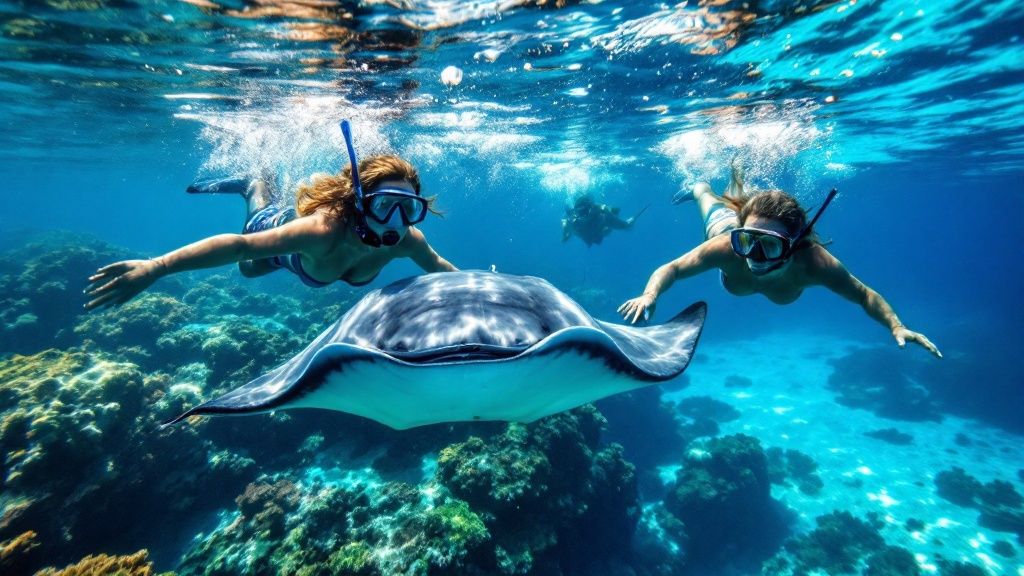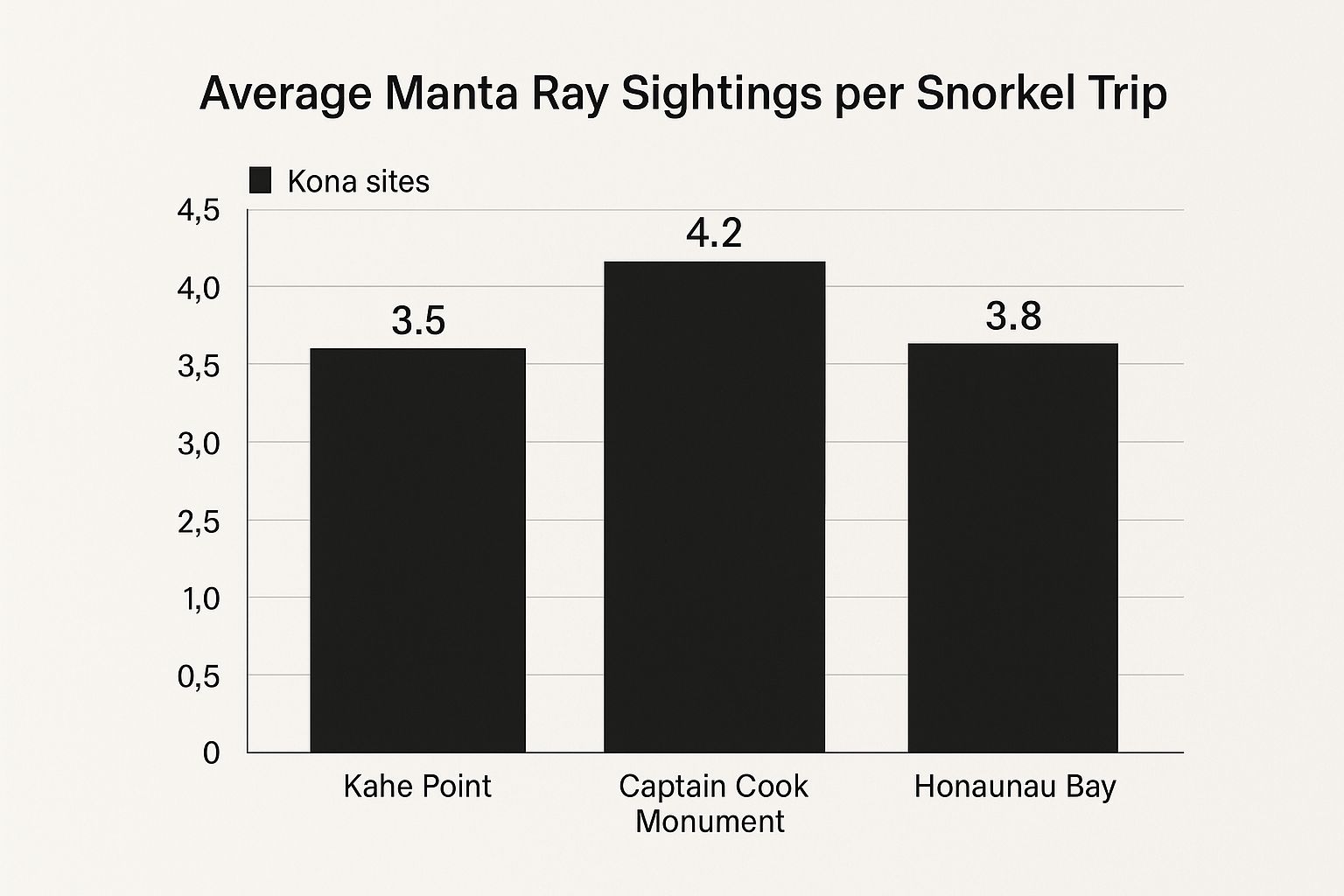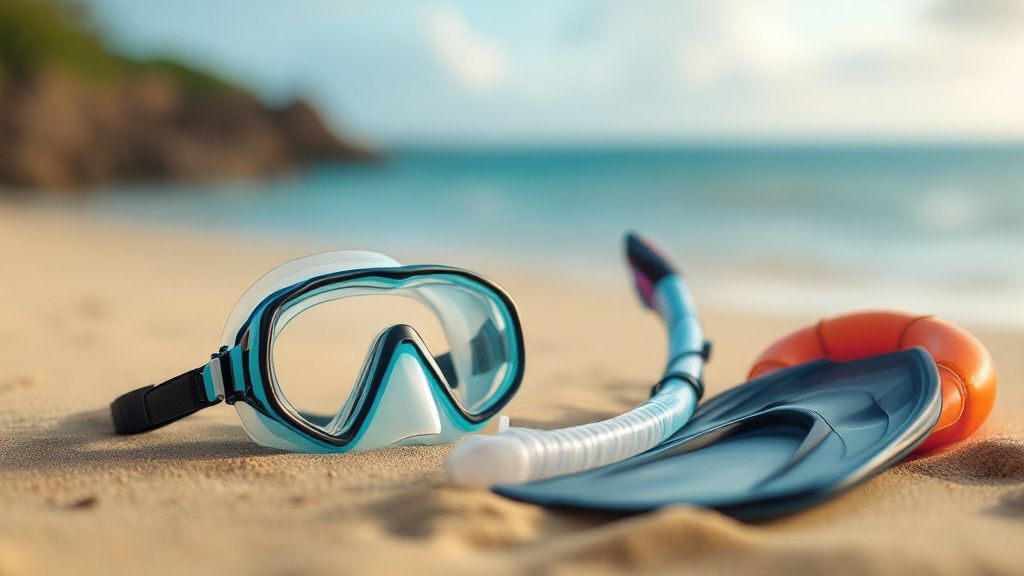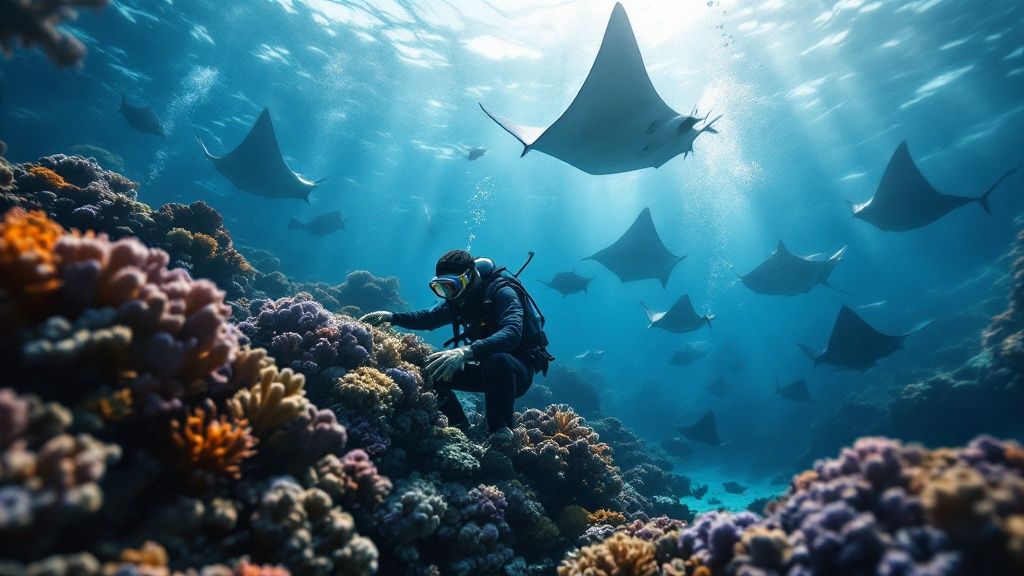Manta Ray Snorkel Kona: Experience Hawaii's Underwater Magic
- Byron
- May 14
- 11 min read
The Magic Behind Kona's Manta Ray Encounters

The Kona coast of Hawaii isn't just another pretty place; it's a sanctuary for manta rays, and a dream destination for anyone hoping to see them. This special ecosystem has the perfect combination of factors that make it a manta ray paradise. The volcanic landscape creates nutrient-rich waters that support a thriving plankton population, the main food source for manta rays.
These gentle giants, called 'hahalua' in Hawaiian, come to these areas to feed. This makes a manta ray snorkel experience in Kona truly special. For a complete guide to planning your own encounter, check out this resource: Manta Ray Snorkel Kona Hawaii: The Ultimate Experience Guide.
The Allure of Plankton-Rich Waters
The abundance of plankton explains why manta rays gather in Kona's waters. The unique underwater landscape and ocean currents create natural plankton traps. Shallow, protected bays, like the famous "Manta Village," become natural feeding grounds.
Volcanic slopes channel nutrient-rich water upwards, constantly supplying food for the plankton. This, in turn, attracts large numbers of manta rays. This reliable food source helps Kona maintain an 80-90% success rate for manta ray sightings, attracting approximately 80,000 visitors every year. For more detailed statistics, see: Manta Ray Snorkeling Kona: Unforgettable Encounters. You can also explore: Our blog post archive.
A Transformative Experience
What makes a Kona manta ray encounter stand out is the sheer grace and size of these creatures. Imagine floating in the dark ocean as these massive, yet gentle, giants glide beneath you, their wingspans reaching up to 18 feet.
It's an experience often described as transformative. Witnessing such a spectacle creates a deep appreciation for the ocean's wonders. The nighttime setting adds a sense of mystery and awe, enhancing the already magical experience. The combination of natural beauty, unique wildlife, and nighttime magic creates an unforgettable memory.
Prime Locations for Manta Ray Encounters in Kona
Not all manta ray snorkel sites are the same. Each spot offers unique characteristics impacting manta ray behavior, water conditions, and the overall viewing experience. Knowing these differences helps you pick the perfect location for your manta ray snorkel Kona adventure.
Kona's Famous Manta Ray Hotspots
Two locations consistently rank high for manta ray sightings: Manta Village and Manta Heaven. Manta Village, nestled in Keauhou Bay, is famous for its calm, shallow waters and abundant plankton. This makes it perfect for families and first-time snorkelers. The bay's sheltered position often leads to calmer waters.
Manta Heaven, near Garden Eel Cove, offers a contrasting experience. Situated further north along the Kona Coast, it's known for potentially larger manta ray gatherings. The slightly deeper water and open ocean conditions create a more adventurous setting.
Exploring Kona's Hidden Manta Ray Gems
Beyond these popular spots, experienced operators sometimes explore lesser-known locations when conditions align. These hidden gems offer a chance for a more intimate manta ray experience, often with fewer people. If you're looking to venture beyond the usual snorkeling sites, explore our sitemap for more information: All Pages on Our Site.
Understanding Location Dynamics
Several factors contribute to each location's appeal. The Kona coast's volcanic topography creates nutrient-rich waters, supporting flourishing plankton populations. Specific ocean currents and water temperatures influence where plankton gathers, directly impacting manta ray feeding habits. For instance, historical data (2009-2014) from Manta Ray Advocates Hawaii provides insights into manta ray sightings along the Kona Coast, revealing consistent activity at sites like Manta Heaven and Manta Village.
To help illustrate the differences between some popular locations, take a look at the comparison table below:
Manta Ray Snorkel Sites in Kona Comparison of the main manta ray snorkeling locations along the Kona coast
Location | Success Rate | Access Method | Water Depth | Best Time | Special Features |
|---|---|---|---|---|---|
Manta Village (Keauhou Bay) | High | Boat | Shallow | Sunset-Night | Calm, sheltered bay, ideal for beginners |
Manta Heaven (near Garden Eel Cove) | High | Boat | Moderate | Sunset-Night | Open ocean, potential for larger groups |
Captain Cook Monument (Kealakekua Bay) | High | Boat | Moderate | Daytime | Historical site, vibrant reef |
Kahe Point (North Kona) | Moderate | Shore/Boat | Varies | Daytime | Accessible from shore, diverse marine life |
Honaunau Bay (Place of Refuge) | Moderate | Shore/Boat | Shallow | Daytime | Historical site, calm waters |
This table highlights the varying characteristics of each snorkel site. From the calm, shallow waters of Manta Village, perfect for beginners, to the open ocean experience at Manta Heaven, there's a location suited to every snorkeler's preference. Factors like water depth, best time to visit, and unique features help distinguish each site, ensuring a diverse range of snorkeling adventures.

The chart above visualizes the average manta ray sightings per snorkel trip at three popular Kona locations: Kahe Point, Captain Cook Monument, and Honaunau Bay. Captain Cook Monument boasts the highest average, with 4.2 sightings per trip, making it a promising spot. This difference in sighting frequency underscores the importance of carefully selecting your location for your manta ray snorkel Kona excursion.
Your Manta Ray Adventure: What Really Happens

So, you're thinking about a manta ray snorkel adventure in Kona? Let's explore what you can expect from this incredible experience, from the initial boat boarding to the magical encounter itself. We'll go beyond the typical brochure to give you a real sense of what awaits.
From Shore to Ocean: The Journey Begins
Your adventure begins with a pre-tour briefing. Your guides will introduce you to the essential equipment, including the wetsuit, mask, snorkel, and fins. They'll also explain the function of the light boards. These boards aren't just for seeing in the dark; they attract plankton, the manta rays' primary food source.
This creates a perfect viewing area, drawing the mantas closer. You'll be floating above the light, looking down to observe the manta rays as they feed. Next, you'll enjoy a short boat ride to the snorkel site.
During the trip, your guides will share fascinating insights into manta ray behavior and biology. They'll also review important safety procedures and answer any questions. This sets the stage for a safe and informative experience.
Entering the Water: A Magical Moment
Once you arrive at the snorkel site, you'll enter the water and hold onto the provided floatation devices. The water temperature is usually comfortable, averaging around 75-80 degrees Fahrenheit. This pleasant temperature makes for a great snorkeling experience, even at night.
The wetsuit offers additional warmth and buoyancy. Even if you're not a confident swimmer, the floatation devices and the guides' support ensure everyone can participate.
The Manta Ray Ballet: An Unforgettable Sight
As your eyes adjust to the darkness, you'll start to see the graceful manta rays appear. These majestic creatures, with wingspans reaching up to 18 feet, glide effortlessly beneath you, feeding on the plankton drawn in by the lights. It's a truly captivating spectacle. Check out our blog categories for more information.
The manta rays often come remarkably close, sometimes mere inches from your mask. This proximity provides an exceptional view of their unique markings and graceful movements.
Ensuring Safety and Respect: The Guides' Role
Throughout the encounter, the guides play a vital role in ensuring both your safety and the well-being of the manta rays. They'll monitor the group, making sure everyone stays together and follows the correct etiquette for interacting with these gentle giants.
This includes maintaining a respectful distance and avoiding any contact with the animals. This protects the manta rays' sensitive skin and allows them to feed undisturbed. The guides' experience and dedication add another level of comfort and security to your adventure.
They are trained to handle various situations and are passionate about sharing their knowledge and love for these amazing creatures. The whole experience is designed to minimize disturbance to the manta rays' natural environment while maximizing the thrill of the encounter for you. It's a truly special way to experience the wonder of Kona's underwater world.
Timing Your Manta Ray Snorkel: Seasonal Sweet Spots
Manta rays are year-round residents of Kona's waters. However, understanding the seasonal variations can greatly enhance your manta ray snorkel Kona experience. Just like businesses adapt to seasonal changes, planning your snorkel around these nuances is key to a truly magical encounter. Factors such as ocean conditions, plankton availability, and even manta ray behavior subtly shift with the Hawaiian seasons.
Summer vs. Winter: Finding Your Balance
Summer typically boasts calmer waters. This makes it a great time for those new to snorkeling. However, winter sometimes offers a different advantage: larger manta ray gatherings. The colder months can see these magnificent creatures congregating in specific feeding areas. This presents a classic trade-off: calm seas versus the potential for more manta encounters. The "best" season truly depends on your personal preferences and comfort level in the water.
Moon Phases, Rainfall, and Climate: The Subtle Influences
The moon's cycle has a significant impact on plankton visibility. A darker night sky, especially during a new moon, amplifies the plankton's bioluminescence. This creates a breathtaking, almost otherworldly backdrop for the manta rays as they feed. Rainfall can also affect water clarity, while broader climate patterns can influence both visibility and manta ray feeding habits. For more information, check out our site's pages.
Fine-Tuning Your Timing for Peak Encounters
Beyond the general seasonal trends, smaller timing details can elevate a good snorkel to an exceptional one. Sunset is often the ideal departure time for evening tours. This allows you to witness the magical transition from day to night as the manta rays begin their graceful feeding ballet. Even recent weather can play a role, as rain and wind impact plankton distribution and, in turn, manta ray activity.
To help you plan your perfect manta ray experience, we've put together a handy guide:
To help you plan your perfect manta ray experience, we’ve put together a handy guide:
Seasonal Manta Ray Snorkel Guide Monthly breakdown of conditions and sighting characteristics for manta ray snorkeling in Kona
Month | Water Visibility | Ocean Conditions | Typical Group Size | Recommended For |
|---|---|---|---|---|
April - May | High | Calm to Moderate | Medium | All levels |
June - September | Very High | Calm | Medium to Large | All levels, families |
October - November | High | Moderate | Medium | Intermediate snorkelers |
December - March | Moderate to High | Variable, can be rough | Large | Experienced snorkelers |
This table provides a general overview, and actual conditions can vary. Always check with local tour operators for the latest information and recommendations. As you can see, certain months offer calmer waters, while others boast potentially larger manta ray gatherings.
Planning Your Perfect Manta Day
Understanding these timing factors empowers you to plan not just the best month for your visit, but also the best days within your Hawaiian vacation. With this insider knowledge, you can maximize your chances of a truly extraordinary manta ray encounter. By considering these seemingly small but significant timing details, your manta ray snorkel Kona adventure becomes more than just a trip – it becomes a carefully orchestrated encounter with these gentle giants.
Selecting Your Perfect Manta Ray Tour Operator

With so many tour operators offering manta ray snorkel Kona experiences, finding the perfect one can be a challenge. Knowing what separates a truly great tour from an average one is key to having an unforgettable adventure. By focusing on a few important factors, you can ensure a safe, enriching, and truly magical encounter with these gentle giants.
Marine Biology Expertise and Guide-to-Guest Ratios
When choosing a tour operator, prioritize those with a strong foundation in marine biology expertise. Knowledgeable guides can offer fascinating insights into manta ray behavior, ecology, and current conservation efforts. This educational component adds significant depth to your overall experience.
Smaller guide-to-guest ratios are also essential. This allows for more personalized attention and creates a safer environment for both you and the manta rays. A lower ratio also means guides can easily address individual questions and needs.
Vessel Comfort and Manta Ray Welfare
A comfortable boat ride is an important factor to consider, especially if you are prone to seasickness. Look for vessels with ample space, comfortable seating, and convenient facilities. This makes the journey to and from the snorkel site enjoyable and relaxing.
Equally crucial is the operator's commitment to manta ray welfare. Responsible operators adhere to the Manta Ray Viewing Standards, minimizing any disturbance to the animals and their habitat. This involves maintaining respectful distances, avoiding any physical contact, and employing eco-friendly practices. You can explore more about responsible tourism practices in our blog post archive.
Practical Considerations and Emergency Protocols
Practical details can significantly impact your experience. Inquire about the quality of the provided snorkel equipment. Well-maintained gear ensures a comfortable and enjoyable snorkel. Ask about emergency protocols and how the operator accommodates different swimming abilities.
A responsible operator should be well-prepared for any situation and cater to all skill levels. For example, a guide experienced in working with less-confident swimmers can make a big difference in someone's comfort level in the water.
Certifications, Group Size, and Questions to Ask
While certifications are valuable, don’t rely on them solely. Look for operators who demonstrate a genuine passion and respect for manta rays. Smaller group sizes, ideally around 10-15 people, offer a more intimate and less crowded experience. This also allows for more personalized interaction with your guides.
Before booking, don't hesitate to ask specific questions about the operator's experience, conservation efforts, and safety procedures. A reputable operator will gladly provide detailed and transparent answers.
Choosing the Right Fit
By carefully considering these factors, you can choose a manta ray tour operator that perfectly aligns with your values and expectations. This not only guarantees a memorable experience for you but also contributes to the long-term protection of these gentle giants and their ocean home. Selecting the right operator is the first step towards an unforgettable encounter with these magnificent creatures.
Mastering Your Manta Ray Encounter: Insider Preparation
Transforming your manta ray snorkel Kona experience from memorable to extraordinary begins with proper planning. Seasoned guides, underwater photographers, and experienced snorkelers agree: knowing what to wear, what to bring, and what to expect before entering the water significantly enhances comfort and enjoyment.
Gearing Up for Success: Clothing and Equipment
The right attire is essential for a comfortable night snorkel. A 3mm wetsuit offers ideal warmth and buoyancy, even in Kona's generally warm waters. While the average water temperature is around 75-80 degrees Fahrenheit, a wetsuit provides extra protection against chills, particularly after sunset.
If you own a mask and snorkel, consider bringing them. This guarantees a perfect fit and optimal comfort. If using provided equipment, ensure a proper fit and functionality before departure. Applying anti-fog solution to your mask is vital for clear underwater visibility.
Mastering the Art of Night Snorkeling
Night snorkeling can feel a little intimidating for first-timers. However, a few simple techniques can boost anyone's confidence in the water. Practice slow, deep breaths through your snorkel to regulate breathing and avoid hyperventilation. A pool noodle or flotation device offers additional support and conserves energy, allowing you to fully appreciate the manta rays.
Proper positioning enhances the viewing experience. Float horizontally above the light board, facing downwards, to observe the manta rays feeding. Avoid touching the manta rays, as this can disrupt their natural behavior and damage their sensitive skin.
Handling Specific Scenarios: Seasickness and Photography
If prone to seasickness, take precautions before the boat trip. Motion sickness medication or acupressure wristbands can help manage symptoms. Staying hydrated and focusing on the horizon can also minimize discomfort.
Capturing impressive underwater photos in challenging night conditions requires specific equipment and techniques. A waterproof camera with a powerful flash and high ISO capabilities is essential. Practicing underwater photography skills in daylight prepares you for nighttime shots.
Family, Seniors, and Accessibility Considerations
A manta ray snorkel Kona adventure is suitable for people of all ages and abilities. Families with young children can choose operators specializing in family-friendly tours with experienced guides trained to assist younger snorkelers.
Seniors can also thoroughly enjoy the experience. Discuss any physical limitations or health concerns with the tour operator in advance to ensure proper support and accommodations. Many operators provide customized experiences.
For individuals with limited mobility or water experience, some operators offer specialized equipment and individual guidance. Discuss accessibility options and request assistance as needed.
By following these tips and anticipating potential challenges, you can transform your manta ray snorkel Kona experience into an unforgettable adventure. These preparations ensure that everyone in your group can fully appreciate this incredible encounter, creating lasting memories.
Experience the magic of manta rays in Kona with our expertly guided tours! Book your unforgettable adventure today: Manta Ray Night Snorkel Kona Hawaii Tours
Comments